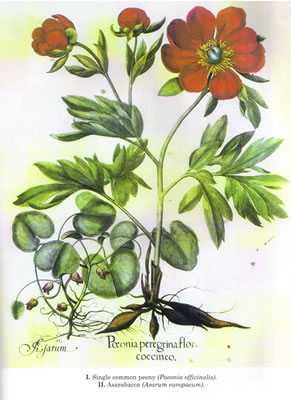White Peony Paeonia albiflora

White double peony
- Common Names
- White Peony root , Bai Shao Yao, Peony root, and Chinese Peony
- Botanical Name
- Paeonia albiflora
- Syn. P. lactiflora, P. officinalis
- Family
- Paeoniaceae
Medicinal Uses & Benefits of White Peony Root
![]() How to Use|
Side Effects |
Plant & Garden|
How to Use|
Side Effects |
Plant & Garden|
- Medicinal Uses: * Chinese
* Colds
* Cuts & Wounds
* Headache/Migraine
- Properties: * Analgesic * Anodyne * Anti-inflammatory * Antispasmodic * Depurative * Emmenagogue * Febrifuge * Vulnerary
- Parts Used: Root
- Constituents: astragalin,benzoic-acid, calcium,copper,gallic-acid,glucose,linoleic-acid,magnesium,paeoniflorin,paeonol,potassium,tannin ,zinc
How to Use: White Peony
Preparation Methods & Dosage :Peony root can be taken as a tea, extract or in capsules.
Traditional Chinese Medicine
 Chin-shao-yao refers to white flowered peony, Paeonia albiflora, Mu-sao-yao, which may be Paeonia officinalis in some cases. The plant is found growing wild, and is cultivated for its root which is much prized by Chinese doctors. It is used as a tonic, alterative, astringent and general remedy in the diseases of women. It is specially recommended in pregnancy. Peony is said to be anodyne, diuretic and carminative. It has special action upon the spleen, liver, stomach and intestines and is prescribed in nosebleed, wounds and other hemorrhages. Tree peony or Mou-Tan, Paeonia moutan is known as the king of flowers. The bark of the root is the part used medicinally for fevers, colds, nervous disorders, hemorrhages, headaches and menstrual difficulties.
3
Chin-shao-yao refers to white flowered peony, Paeonia albiflora, Mu-sao-yao, which may be Paeonia officinalis in some cases. The plant is found growing wild, and is cultivated for its root which is much prized by Chinese doctors. It is used as a tonic, alterative, astringent and general remedy in the diseases of women. It is specially recommended in pregnancy. Peony is said to be anodyne, diuretic and carminative. It has special action upon the spleen, liver, stomach and intestines and is prescribed in nosebleed, wounds and other hemorrhages. Tree peony or Mou-Tan, Paeonia moutan is known as the king of flowers. The bark of the root is the part used medicinally for fevers, colds, nervous disorders, hemorrhages, headaches and menstrual difficulties.
3
Plant Description

Basilus Besler Poenia Officinalis
- Flowers:Usually white , some shaded in pink,yellow and red, strongly fragrant Some cultivars have double flowers
- Plant Class: herbaceous perennial
- Leaves: Compound, deeply lobed
- Fruit:
- Preferred Habitat:
- Flowering Season:Late spring, early summer
- Distribution: Native to Europe, Asia, and North America
Regional Traditions :Traditional Chinese Medicine *
How to Grow White Peony
The common garden peony is one of the most widely grown perennials throughout the Northern hemisphere. Peonies are generally planted in the fall, but they may also be available in spring as potted plants. For those herbaceous peonies obtained in the fall, be sure the tuber has three to five buds or "eyes" present. They will be bright red in color. Tree peonies are grown either from seed or grafts, with the more desirable way for the home gardener being grafted plants. Herbaceous peonies with three to five "eyes" will generally flower the second year after planting, while it will take three years for a grafted tree peony. 2
Related Species Paeonia suffruticos Tree peony ,Mu Tan is a symbol of love and affection and an official herb in the Chinese Pharmacopeia
History and Traditions & Folklore
 It is an herb of the Sun, and under the Lion. Physicians say, Male Peony roots are best; but Dr. Reason told me Male Peony was best for men, and Female Peony for women, and he desires to be judged by his brother Dr. Experience. The roots are held to be of more virtue than the seed; next the flowers; and, last of all, the leaves
It is an herb of the Sun, and under the Lion. Physicians say, Male Peony roots are best; but Dr. Reason told me Male Peony was best for men, and Female Peony for women, and he desires to be judged by his brother Dr. Experience. The roots are held to be of more virtue than the seed; next the flowers; and, last of all, the leaves
Nicholas Culpeper, 1653
- Steven Foster and Yue chongxi . Herbal Emissaries (1992)
- University of Vermont Extension Department of Plant and Soil Science. Growing Peonies
- Li Shih-Chen.(1578) Translation: Bliss, Beatrice. "Chinese Medicinal Herbs A Modern Edition of a Classic Sixteenth-Century Manual", Georgetown Press(1973). Dover (2003)











